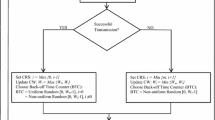Abstract
Distributed Coordination Function (DCF) is the basis of IEEE 802.11 MAC sublayer. To improve energy efficiency, IEEE 802.11 has specified power saving mechanism (PSM) for DCF. However, the performance of PSM degrades seriously when load is heavy. In this paper we first analyze the reason of performance degradation, and then propose two adaptive mechanisms: PSM+ and fairPSM+. Numerous simulation results have shown that these two mechanisms can achieve high performance with heavy load and still get the same performance as PSM when load is light.
Similar content being viewed by others
References
V. Bharghavan, A. Demers, S. Shenker and L. Zhang, MACAW: A media access protocol for wireless LAN’s, ACM SIGCOMM, 1994.
G. Bianchi, Performance analysis of the IEEE 802.11 distributed coordination function, IEEE Journal on Selected Area in Comm. 18(N3) (2000).
Luciano Bononi, Marco Conti and Lorenzo Donatiello, A distributed mechanism for power saving in: IEEE 802.11 wireless LANS, Mobile Networks and Applications (2001.6) pp. 211–222.
F. Calì, M. Conti and E. Gregori, Dynamic tuning of the IEEE 802.11 protocol to achieve a theoretical throughput limit, IEEE/ACM Trans. Networking, December. 2000.
A. Chandrakasan and R.W. Brodersen, Low Power Digital CMOS Design (Kluwer Academic Publishers, Norwell, MA, 1995).
IEEE802.11 WaveLAN PC Card—User’s Guide, p. A-1.
R Jain, The Art of Computer Systems Performance Analysis[M] (John Wiley and Sons, 1991).
E.-S. Jung and N.H. Vaidya, An energy efficient MAC protocol for wireless LANs, in: Proc. INFOCOM 2002, June 2002.
LAN MAN Standards Committee of the IEEE Computer Society, IEEE Std 802.11–1999, wireless LAN medium access control (MAC) and physical layer (PHY) specifications, IEEE, 1999.
J.P. Monks, V. Bharghavan and W.W. Hwu, A power controlled multiple access protocol for wireless packet networks, Proc. INFOCOM 2001, pp. 219–228, 2001.
NS2, URL http://www.isi.edu/nsnam/ns/
R. Powers, Advances and trends in primary and small secondary batteries, IEEE Aero. Elec. Sys. Mag. 0(4) (April. 1994).
V. Rodoplu, and T Meng, Minimum energy mobile wireless networks, IEEE Journal on Selected Areas in Communications, pages (1999) 1444–1344.
Suresh Singh and C.S. Raghaverdra, PAMAS—power aware multi-access protocol with signalling for ad hoc networks, ACM computer communication review, 1998.
Mark Stemm and Randy H. Katz, Measuring and reducing energy consumption of network interfaces in hand-held devices, IEICE Transactions on Communications, special Issue on Mobile Computing, E80-B(8) (1997) 1125–1131.
C.K. Toh, Maximum battery life routing to support ubiquitous mobile computing in wireless ad hoc networks, IEEE Comm. Mag. (June 2001) 138–147.
Y.-C. Tseng, C.-S. Hsu and T.-Y. Hsieh, Power-saving protocols for IEEE 802.11-based multi-hop ad hoc networks,” in: Proc. INFOCOM 2002, June 2002.
H. Woesner, J.P. Ebert, M. Schlager and A. Wolisz, Power-saving mechanisms in emerging standards for wireless LANs: The MAC level perspective, IEEE Personal Communications (Jun 1998) 40–48.
Xue Yang and H. Nitin Vaidya, DSCR: A more stable MAC protocol for wireless networks, UIUC technical report, August 2002.
W. Ye, J. Heidemann and D. Estrin, An energy-efficient MAC protocol for wireless sensor networks, in: Proc. INFOCOM 2002, June 2002.
M. Zorzi and R.R. Rao, Energy efficiency of TCP in a local wireless environment, ACM/Baltzer Mobile Networks and Applications 6 (2001) 265–278.
Author information
Authors and Affiliations
Corresponding author
Additional information
Shihong Zou was born in 1978. He received his Bacchelor of Engineering degree in Computer Engineering from Nanjing University of Posts and Telecommunications (Nanjing, China) in 1999, and his Ph.D. degree in communication and information systems from Beijng University of Posts and Telecommunications (BUPT) in 2004. He is currently a lecturer in BUPT. His research interests include IP QoS, WLAN, mobile ad hoc networks and network security.
Haitao Wu was born in 1976. He received his Bachelor of Engineering (B.E.) degree in Communication Engineering from Beijing University of Posts and Telecommunications (BUPT) in 1998, and his Ph.D. degree in communication and information systems from BUPT in 2003. He is currently a Post-doctor in Microsoft Research Asia (MSRA), wireless and networking group. His research interests include IP QoS, TCP/IP, wireless networks and peer-to-peer networks.
Shiduan Cheng graduated in communication engineering at the Beijing University of Posts and Telecommunications (BUPT) in 1963. Since then she has been working at BUPT. From 1984 to 1987 and in 1994 she twice joined Alcatel Bell, Belgium as a visiting scholar, where she was involved in R&D work on ISDN and B-ISDN networks and systems. She became vice dean of the computer department of BUPT in 1987. From 1992 to 1999 she was the director of The National Key Laboratory of Switching Technology and Telecommunication Networks of BUPT. In the same duration she was also the head of The Switching and Networking Expert Group in 863 program, a national high-tech R&D plan organized by The Ministry of Science and Technology of China. She has published more than 100 papers and several books in the field of telecommunications. She is currently the vise director of Standing Committee of Science of BUPT. Her research interests cover ISDN, ATM, TCP/IP, switching software, protocol engineering, traffic engineering, network performance, QoS, security and survivability. Currently she is working on QoS control, measurement and management for the next generation Internet.
Rights and permissions
About this article
Cite this article
Zou, S., Wu, H. & Cheng, S. Adaptive Power Saving Mechanisms for DCF in IEEE 802.11. Mobile Netw Appl 10, 763–770 (2005). https://doi.org/10.1007/s11036-005-3369-4
Issue Date:
DOI: https://doi.org/10.1007/s11036-005-3369-4




